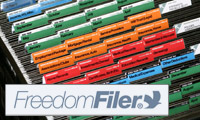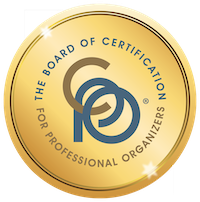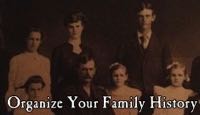Great sale on shelving AND Elfa at the Container Store
If you’re in the market for shelving or Elfa, now’s the time to buy! At the beginning of every year the Container Store has a sale on Elfa, its fabulous shelving and drawer system. And then in the fall they have a shelving sale. If I’m remembering correctly, the only Elfa that was included in that sale was shelving.
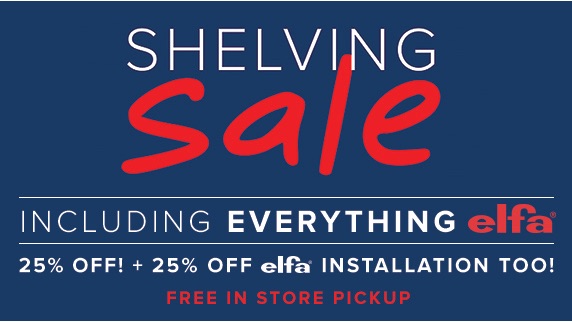
But this year is different. The shelving sale going on right now gets you 25% off all shelving, plus all Elfa, including drawers and other components, as well as Elfa installation. It makes me wish I had the need to buy some!
I use Elfa in my own home to store my yarn stash (as I mentioned in a post earlier this week). And I have a small Elfa system in a reach-in closet in my office. I also have three Elfa file carts in use. I’ve used Elfa drawers (similar to the ones I use for yarn) in several clients’ homes to house kids’ toys. And I have a couple of clients with small children who have really enjoyed the Elfa Kids’ Coloring Table
Tempted? The sale ends October 16.
Worth repeating: The joy of an organized yarn stash

Eight years ago, I organized my yarn into a bank of Elfa drawers. (Incidentally, Elfa is on sale right now for 25 percent off!) Four years ago, I blogged about how wonderful it is to have an organized stash. Today, I am repeating that post because is as true now as it was then. And, of course, it’s also true for fabric, beads or any other kind of craft supplies you might have.
I’m a knitter, and like most knitters, I have quite a bit of yarn. I don’t go out and buy yarn for the sake of buying it. Typically, I purchase yarn for specific projects. But sometimes those projects don’t pan out and I unravel them. And lots of times, I have yarn left over after finishing a project. Multi-color projects, in particular, can lend themselves to a lot of leftover yarn.
But the good news (for me) is that my yarn stash is well organized. As I have mentioned here, back in 2008 I purchased a bank of Elfa drawers to organize my yarn and knitting supplies. Four years later, I’m still thrilled with the system.
Case in point: A friend had a baby recently and I decided to knit the baby a teddy bear. I’ve knitted several teddy bears, out of a plush yarn called Oh My! My friend Lisa knit a different bear recently and I wanted to try out that free pattern. Alas, the yarn called for in the pattern is now discontinued and I wasn’t willing to go to a lot of work to try to track it down.
So yesterday, I wondered whether I had any Oh My! yarn left over from past bears. That teddy bear has a little sweater, so I thought maybe there would be some leftover pink yarn out of which I could knit a tiny scarf for the new bear.
I knew exactly where to look: the drawer marked “novelty yarn.” To my delight, I found 1.5 skeins of teddy-bear brown Oh My! And I also found some colored yarn for the scarf. No trip to the yarn store necessary for me. No money needed to spent. I can start on this pattern as soon as I get home. [2016 addition: That’s a picture of the completed bear at the top of this post.]
My organized yarn stash saved me time and money yesterday. It allowed me easy access to my yarn without any frantic searching. It also helps my stash stay neat and tidy. I love my Elfa drawers!
Old jeans take on a new life in St. Louis
I wrote a blog post a few years back about Charity Sharity, an organization in St. Louis that collects fabric to distribute to groups for charity sewing projects.
Just last week I received an email from Sally Safranski of DenimQuilts, a group allied with Charity Sharity. These talented quilters take donated blue jeans and use them to create personalized quilts. Last month they created their 1,000th quilt! Most of the quilts go to kids in foster care and others go to children and families currently grieving for someone close to them who has died or is in hospice. Some are donated to charity fundraisers.
DenimQuilts volunteers use pockets from the jeans to machine personalize the quilt with an embroidered, name, image or message. Here are a couple of photos of a quilt made by DenimQuilts volunteers:
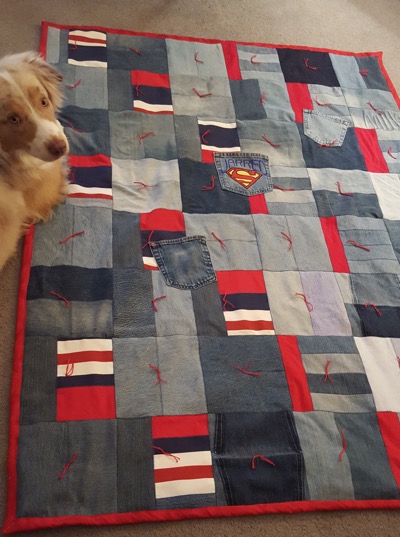
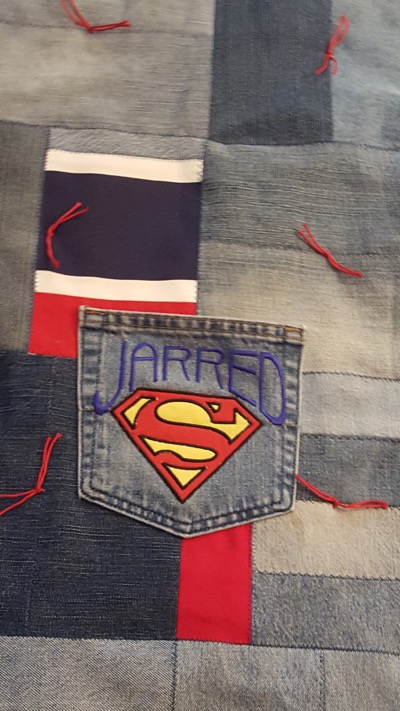
Sally wrote me, “We accept all types and conditions of jeans from non-smoking homes. Those that are teen/young adult friendly might be sent to Epworth in Webster for their kids on campus or at a homeless youth program in No.Co. We prefer 100% cotton jeans – any color and most any condition. They can be delivered to my home any time – 261 Horseshoe Drive, 63122 (west of Kirkwood Park). I have a covered courtyard entrance – so drop-off without an appointment is easy.”
ETA: If you live outside St. Louis and would like to mail jeans to DenimQuilts, they’ll happily accept your donation. Just mail it to Sally Safranski at the above address. (And remember, the jeans must come from non-smoking homes.)
You can also find DenimQuilts on Facebook. And you can read a feature story about them in a recent edition of the Webster-Kirkwood Times.
I can only imagine how comforting these cozy denim quilts must be to these kids in need. What a wonderful way to make your worn jeans live on.
My new favorite app: NPR One
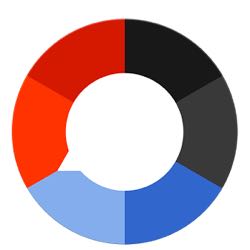
I’m a big fan of National Public Radio. I’ve been listening to it for decades. But in recent years, that fell by the wayside. Instead, I’ve been listening to music on my phone or podcasts that automatically land on my phone. I used to listen to NPR on my car radio (I don’t think I even have a radio in my home any longer), but I’d switch it off if I didn’t like the story.
I do subscribe to a couple of podcasts of favorite NPR shows, including Wait Wait Don’t Tell Me and Ask Me Another.. On those podcasts, I’d hear ads for the NPR One app, which, the ads told me, provides “Hand-picked stories based on what you like.” After months of hearing ads, I finally dowloaded the app.
I am so glad I did! Oh my goodness, NPR One is like the having best of NPR without having to tolerate anything that doesn’t interest me.
I’m probably only skimming the surface, but here’s how I use it. When I open it, I hear the top-of-the-hour news, including news from my local station, KWMU. Then news and feature stories or podcasts start playing. If I’m interested in the story, I touch the word “Interested.” If I don’t want to hear the story, I touch the skip icon. Soon, the app started learning my interests and I now have to skip less often. The more I use it, the better it gets.
The wonderful thing is that I’m keeping up with (some) news and I’m hearing new-to-me podcasts. I’ve discovered the podcast Pop Culture Happy Hour, which I love. I canceled my subscription to Entertainment Weekly after reading it for decades, so it’s helping me stay on top of pop culture.
If you like NPR and use a smartphone, I encourage you to give NPR One a try. It gives you all the benefits of listening to the radio and much, much more.
I'm in a coloring magazine!
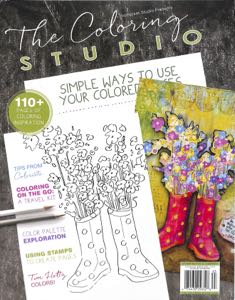
I enjoy coloring in grown-up coloring books and I have blogged here about how I organize my colored pencils and how I organize my coloring Sharpies. I was tickled pink when I was contacted by the editor of The Coloring Studio a quarterly publication from Stampington & Company that’s part magazine, part coloring book, about reprinting some of the information I shared on my blog. The result is an articled called How to Organize Your Coloring Tools.
If you like coloring I think you might like the The Coloring Studio. It’s a high-quality publication that delves into techniques (some I’d never heard of), color palettes and artist profiles, among other things. The Autumn issue (the one that I’m in) goes on sale today! You can order it at the company’s website. The price is $14.99.
Favorite storage features of my new kitchen
This is the third and last post in a series about the kitchen renovation we did this spring. (Click here for the other two posts.)
Today I want to highlight a few of the storage features of my new kitchen that make me smile. Nothing earth-shatteringly innovative here, just really nice conveniences.
Two-tier cutlery drawer
I love how one drawer is now doing the work of two, thanks to the innovative two-tier cutlery drawer.
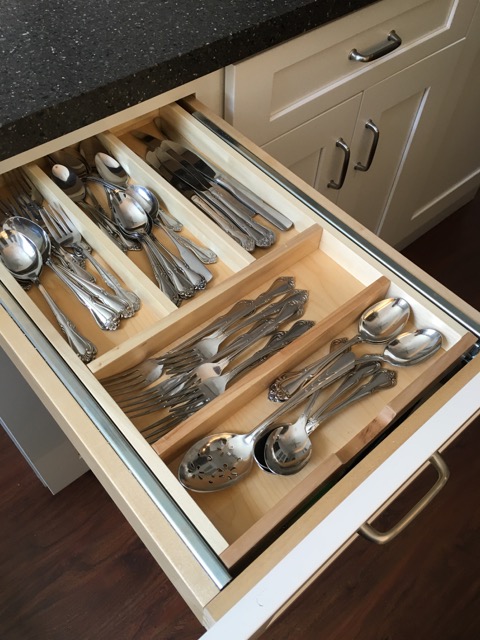
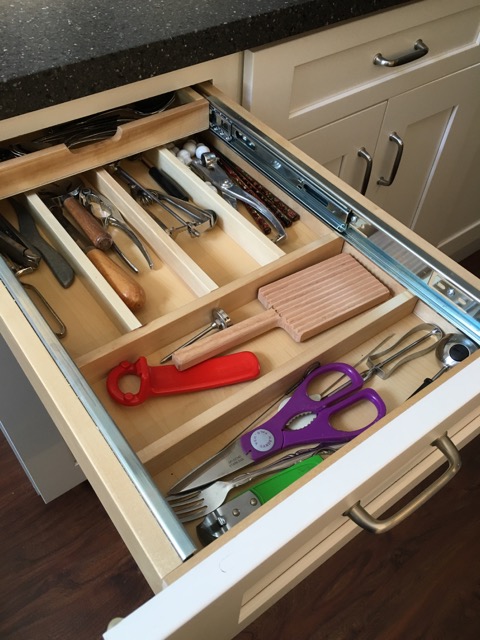
Simple pot lid holder
Two simple maple racks from the Container Store are holding my pot lids upright next to the pots. It’s working out so well and making me crazy happy.

My coffee filter drawer
I take a coffee filter out of this acrylic drawer every day and every day it makes me smile. I love that I found a sturdy drawer that’s exactly the right size I need for my filters. And that I can place the scale I use to weigh my coffee (I’m weird that way) right on top of it. It’s so much better than the flimsy coffee-filter box I used to use.
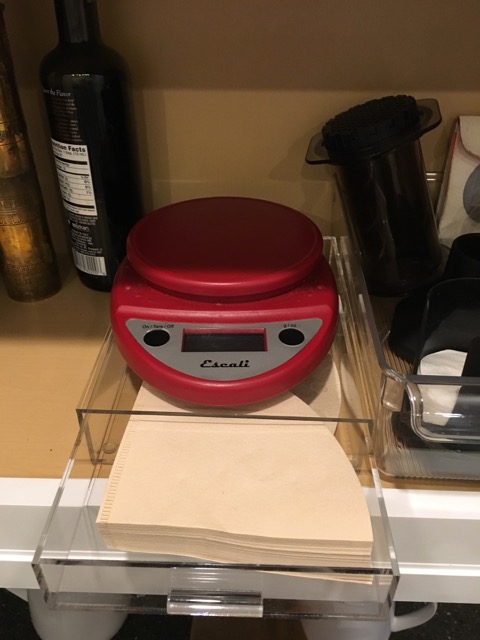
Our barware cupboard
We used to store our barware on the top shelf of the built-in cabinet and I would have to get out a stepstool if the glass I wanted wasn’t right in the very front. A lot of the barware was stored in the basement. Now we have a whole beautiful cabinet that can hold an ample supply of barware. And I love the way it looks. Another happy-making thing.
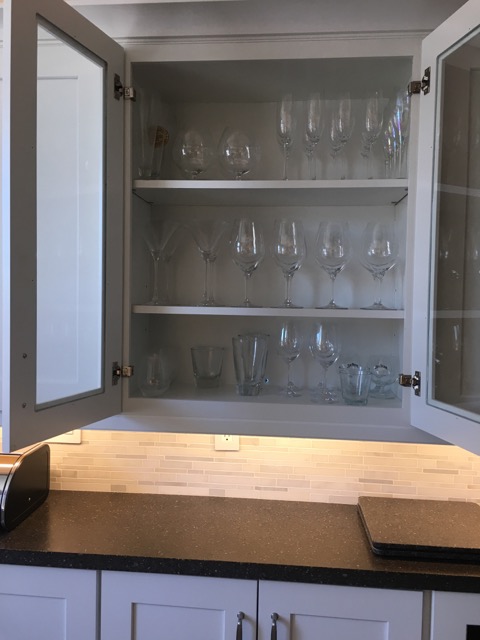
A corner cupboard Lazy Susan that actually works
I’ve seen lots of poorly functioning Lazy Susans in corner cabinets in clients’ kitchens. Ours is working really nicely. One of the things it has going for it is there’s no center pole, so I can use the whole surface. We store frequently used items like mixing bowls and colanders there and it’s conveniently close to the dishwasher. We also store food-storage containers there which, alas, means that I’m storing them nested rather than with lids on. But it’s working out really well. _(ETA: I’ve since learned that this type of Lazy Susan is called a Super Susan
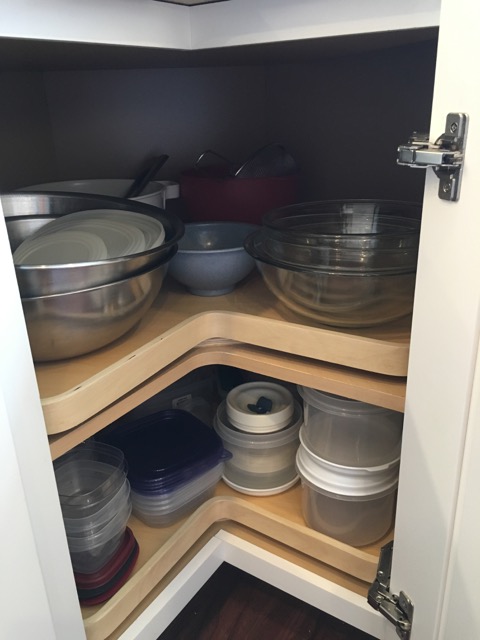
A hideaway spot for my purse
In our old kitchen, I stored my purse on the top shelf of a freestanding cookbook bookcase. That space tended to get quite unruly. Now I use the angled cupboard at the entry to the kitchen from the house. It’s an odd-shaped space so I wasn’t sure how I would use it. I slide my purse in the bottom shelf; we store extra dog food in the top shelf. (We pour the dog food into large Montana glass canisters that we scoop out of. The canisters live in the built-in cabinet, along with treats.)
Here’s a wide shot of the cupboard:
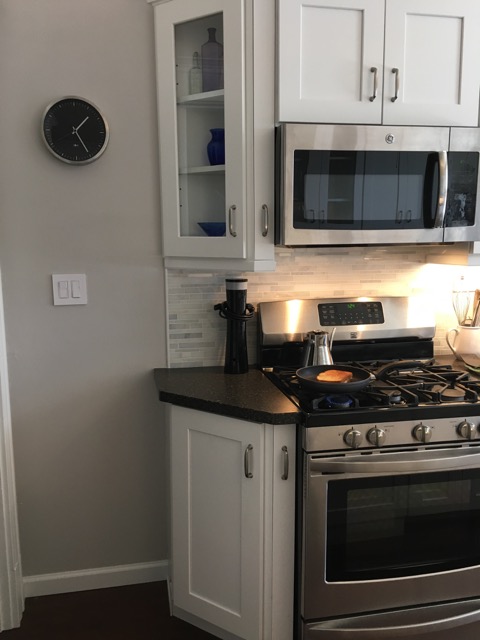
And here’s a closeup of how nicely the shape works for my purse:
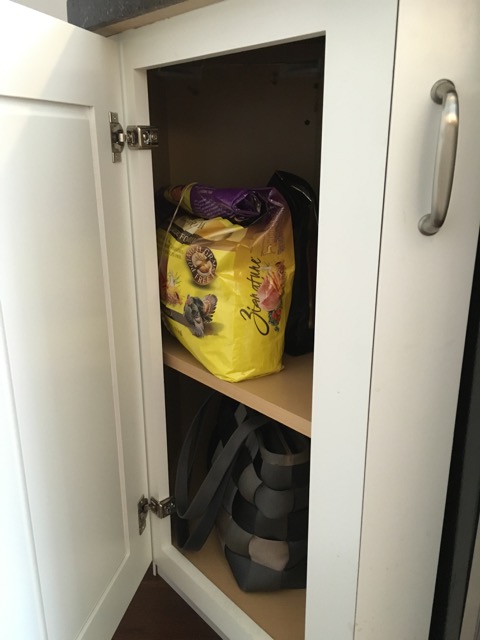
Our pull-out spice racks
Because of the angled countertop, a 3-inch filler was necessary to the left of the range and microwave. We didn’t want to waste space, so we had pull-out spice racks installed there. (You can see them closed in the picture above.) It’s turned out to be very convenient and it’s awfully nice to have a dedicated space for spices that’s not in the way of other things. Another benefit is that it’s really easy to read the spice labels!
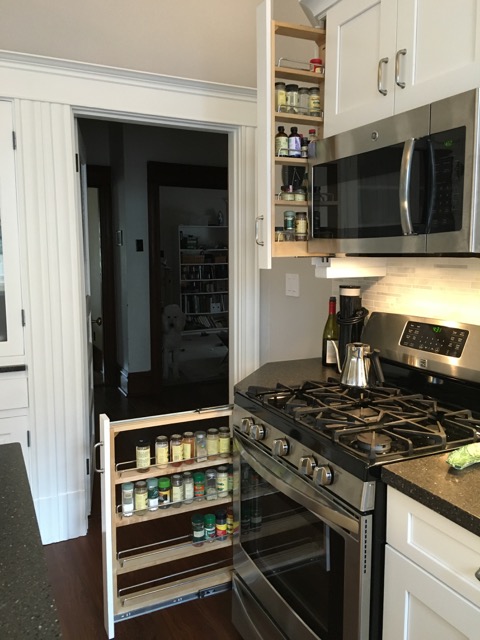
Those are just a few of my favorite things about my new kitchen. It really is a joy.
Lessons learned from our kitchen renovation
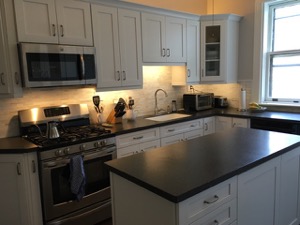
This is the second of three posts on our recent kitchen renovation. I encourage you to also read Happiness is a new kitchen and Favorite storage features of my new kitchen. This kitchen renovation has been a great experience for us so I wanted to share!
Last week, I shared photos of our lovely new kitchen. We’re not quite finished…there’s the tiniest bit of finish work that needs to be done as soon as we get the supplies from the cabinet company. But for all intents and purposes, it’s finished.
We were lucky: ours was a pretty compressed timeline. It went like this:
- March 21: We made an appointment to have our kitchen measured by Home Depot’s installation company
- April 3: We had our first meeting with the Home Depot kitchen designer, Chris Burns, who created a design based on the measurements and photos taken by the installer.
- April 8: We finalized the design with Chris and ordered the cabinets and countertops.
- May 3: Demolition began (all cabinets were removed, with the exception of the built-in); wallpaper had to be removed too
- May 10: Cabinet installation began
- June 1: Countertops were installed
- June 3: Flooring was installed
- June 16-17: Finish work was done and cabinet/drawer hardware was installed
- June 18-19: We moved back into the kitchen!
After that, there was still more finish work to do, along with the replacement of the new floor (more on that later). But starting June 19 the kitchen was fully operational and fully enjoyable.
So we were out of a kitchen from May 3 to June 18, which isn’t bad at all, though it felt like a long time. Looking back, here are some of the lessons I gleaned from the experience. Perhaps they’ll help you if you redo your kitchen.
Lesson 1: It’s worth the hassle. As disruptive as it is to go without a kitchen for weeks or months, the effort is worth it. Having a kitchen designed to your needs, with modern storage conveniences is a joy. You get to factor in your own aesthetic, so it’s beautiful too. The memory of the inconvenience fades, but the reality of the great space remains. (Until it’s time to do it again, which for us will be a very long time from now, if ever.)
Lesson 2: Expectations are everything. Understand that there will be glitches. When you’re told how long something will take, double that time in your head. When you’re given a price, know that the cost will inevitably go up. This is reality. And expecting it will help keep your blood pressure down.
Lesson 3: Limit your options. You can go crazy making decisions if you factor in every option. There are just too many! We went in with a few ideas of what we wanted (painted, not stained, Shaker-style cabinets, dark countertops), we selected a mid-price-range cabinet line and we stuck with those parameters, which limited our choices. My husband, Barry, had some pretty solid ideas of what he was after and when we factored in both our preferences, the options that pleased both of us were whittled down. For us, making quick decisions based on relatively limited choices made the process less agonizing. And, I’m glad to say, we’re happy with the results.
Lesson 4: Don’t be afraid to be a squeaky wheel. We’re lucky because we work from home so we could keep an eye on the kitchen construction easily. Barry wasn’t afraid to speak up if something didn’t look quite right to him, and he has pretty exacting standards. We weren’t afraid to call and check on the status of orders if things seemed to be progressing slowly. Perhaps most significantly, when the installer finished installing the vinyl plank flooring in June, we weren’t shy about calling Home Depot to express concern over some shoddy work. That led to a visit from the supervisor who was very disappointed by his contractor’s workmanship. He suggested a complete replacement of the floor and sent a pair of skilled workers to do the job. The difference was night and day. I’m so glad we didn’t settle for the initial poorly installed floor.
Lesson 5: A little planning goes a long way. We were lucky; since we live in a two-family home, so we have an extra kitchen. It’s a completely substandard kitchen, but it was usable for the six weeks we needed it. We planned well so that we had just the items we needed, with the rest packed away in boxes. We only had to dip into those boxes a couple of times (primarily when Barry decided to make a birthday cake for a friend in May). Another thing I did was create a spreadsheet of where items were stored in the old kitchen and where they would be stored in the new kitchen. That gave me comfort that the new design would work for us. (We lost a pantry in the new design, so I was a little concerned.) That spreadsheet made moving into the new kitchen a breeze.
Lesson 6: If it sounds too good to be true…. Our initial contractor, who had been recommended to us, gave us an incredibly low bid. I figured he was just a really poor estimator and I tripled the amount in my head and was still satisfied. It became apparent with just the small amount of work he did after the demolition that his quality standards were not high enough. So we fired him. Luckily we had discovered a really great contractor, so everything went off without a hitch. But we should have known when we saw the initial contractor’s bid that he wouldn’t be the guy for us.
How about you? For those of you who have been through the experience, what lessons did you learn? Please share!
Links
- Shannon Wilkinson, life coach
- Are you interested in becoming a professional organizer?
- Organize Your Family History
- Peace of Mind Spending
- NAPO St. Louis
- Getting to Good Enough podcast
- Institute for Challenging Disorganization
- National Association of Productivity and Organizing Professionals
- Ravelry

